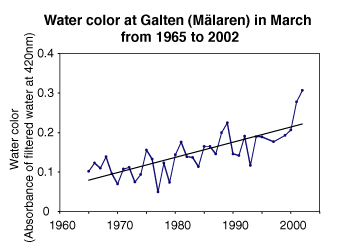 |
||
|
Impacts of warmer winters on water chemistry |
||
|
1. Reactive silica and pH Warmer winter air temperatures cause an increase in water temperatures. Among all variables water temperature is the variable that shows the most coherent response to a changed climate among lakes and lake sites1. As a consequence, variables closely linked to water temperature should also coherently respond to a changing climate. In Sweden's largest lakes Vänern, Vättern and Mälaren, reactive silica and pH are the variables that are most closely linked to water temperature (see figure). These two variables are the only variables that coherently responded to warmer winters at all 16 lake sites in the lakes Vänern, Vättern and Mälaren. Reactive silica concentrations decreased in May and pH increased at all lake sites after winters have been warm. This is most probably a result of the observed earlier phytoplankton spring bloom, causing an earlier increase in pH and an earlier depletion of reactive silica concentrations1. 2. Water color Water color is not as strongly related to water temperature as reactive silica and pH. Consequently, we do not see a synchronous effect of warmer winters on water color among Sweden's largest lakes. We however, see a strong increasing trend of water color in Lake Mälaren (see figure). Trends in water color are often explained by changes in the water discharge as a result of a changed climate. If winters become warmer, drastic changes in the runoff of water during winter occur and spring floods are less developed. This in turn causes changes in the transport of organic material from the catchment areas towards lakes. Water color in Lake Mälaren, measured since 1967, has on average increased by 0.9 - 2.5 % per year2. Especially after the very rainy period at the end of 2000, Mälarens water reached an exceptionally brownish color3. 3. Other chemical variables Warmer winters have an effect on almost all chemical variables in the lakes Vänern, Vättern and Mälaren1. However, as soon as a water chemical variable is not strongly related to surface water temperature, each variable responds differently to warmer winters at each lake site1. |
1 Weyhenmeyer, G. A. 2004. Synchrony in relationships between the North Atlantic Oscillation and water chemistry among Sweden's largest lakes. Limnol. Oceanogr. 49: 1191-1201. 2 Tilja, M. 2004. Water color trends in Lake Mälaren. Master-Thesis, Department of Thematic Studies, Linköping University, Campus Norrköping. 3 Weyhenmeyer, G. A., Willén, E. and Sonesten, L. 2004. Effects of an extreme precipitation event on water chemistry and phytoplankton in the Sedish Lake Mälaren. Boreal Environment Research 9: 409-420. Further reading Blenckner, T. 2001. Climate related impacts on a lake - from physics to biology. PhD-thesis, Acta Universitatis Upsaliensis 674. Güss, S., Albrecht, D., Krambeck, H.-J., Müller-Navarra, D.C., Mumm, H. 2000. Impact of weather on a lake ecosystem, assessed by cyclo-stationary MCCA of long-term observations. Ecology 81: 1720-1735. Pettersson, K., Grust, K., Weyhenmeyer, G. and Blenckner, T. 2003. Seasonality of chlorophyll and nutrients in Lake Erken – effects of weather conditions. Hydrobiologia 506-509: 75-81. Schindler, D.W. 2001. The cumulative effects of climate warming and other human stresses on Canadian freshwaters in the new millenium. Can. J. Fish. Aquat. Sci. 58: 18-29. Straile, D., Livingstone, D. M., Weyhenmeyer, G. A. and George, D. G. 2003. The response of freshwater ecosystems to climate variability associated with the North Atlantic Oscillation. In: The North Atlantic Oscillation. Climate Significance and Environmental Impact. Eds.: J. W. Hurrell, Y. Kushnir, G. Ottersen and M. Visbeck. Geophysical Monograph Series 134: 263-279. Straile, D, Jöhnk, K. and Rossknecht H. 2003. Complex effects of winter warming on the physico-chemical characteristics of a deep lake. Limnol. Oceanogr. 48: 1432-1438. |
|
